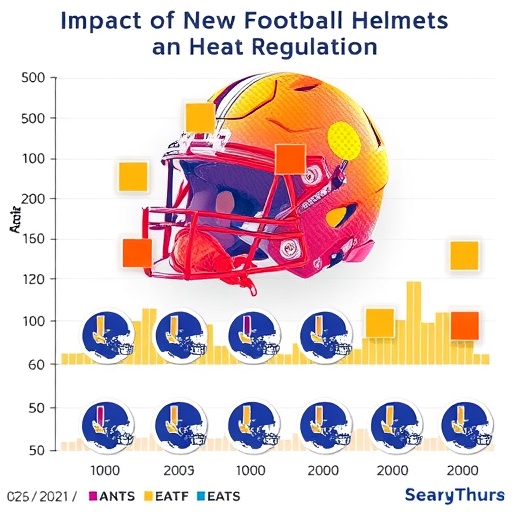In recent years, the safety of athletes has come under scrutiny, particularly in contact sports like American football. Concussions and heat-related illnesses have highlighted the importance of protective gear and its impact on player performance. A groundbreaking study that analyzed newly mandated headgear has surfaced, exploring its effects on thermoregulation during exercise in high-temperature environments. Authored by renowned researchers Langan, Martin, and Thomas, the paper sheds light on significant implications for player safety and performance during games and training.
Thermoregulation is the physiological process that allows the human body to maintain its core internal temperature. It’s a complex system managed mainly through the integration of a variety of physiological mechanisms, such as sweating, shivering, and altering blood flow to different body parts. In sports like American football, players are often exposed to intense heat, which can severely strain these regulatory systems, leading to heat-related illnesses that can compromise health and athletic performance.
According to the study, the requirement for additional headgear in American football comes as a response to increasing instances of concussions among players. However, this new headgear could potentially interfere with the body’s natural cooling mechanisms. The research team aimed to determine whether this newly mandated gear would compromise players’ thermoregulation, especially during bouts of intense physical exertion in the heat.
Participants in the study were subjected to rigorous conditions that mimicked real-game scenarios, where they exercised in high temperatures for extended periods. The researchers meticulously measured various data points, including core body temperature, sweat rate, and heart rate variability, among others. These measurements offered a comprehensive view of how well the athletes could maintain thermoregulation while donning the new headgear.
The implications of the findings are far-reaching. Initial results indicated that the new headgear may inhibit adequate heat dissipation. Some players experienced an elevation in core temperature more significant than what is typically observed when wearing standard helmets. This is particularly concerning considering that an increased internal body temperature can lead to serious complications, including heat exhaustion and heat stroke.
Furthermore, the study notes that during high-intensity intervals, players wearing the new headgear showed lower sweat rates compared to their counterparts wearing traditional equipment. This reduction in sweat production is crucial, as sweating is the body’s primary method of cooling itself down. If athletes cannot sweat efficiently due to the gear, this could impair their performance, ultimately affecting game outcomes.
As competition heats up in the pre-season and regular season schedules, understanding and addressing these thermoregulatory challenges becomes even more critical. Coaches, trainers, and players must be made aware of these potential risks associated with the newly mandated headgear. Appropriate acclimatization strategies and hydration protocols will be essential in helping players adapt to both the physical demands of their sport and the challenges posed by their protective equipment.
The increasing focus on athlete safety also raises questions about the suitability and design of the new headgear. Although the goal is to protect players from head injuries, it is just as vital that safety measures do not inadvertently impose new risks. The research underlines the need for ongoing innovation in helmet design, aiming for a balance that prioritizes both protection and performance.
Moreover, educators and sports organizations at all levels should incorporate findings from this research into their training regimens. Fan engagement and awareness around these issues of heat stress and safety equipment can galvanize support for further research and potential policy changes, ultimately leading to a safer playing environment.
Prioritizing athletes’ health and performance should not only be the responsibility of players and coaches, but also extends to leagues and governing bodies. They are tasked with ensuring that equipment provides the utmost benefits without compromising player safety. Discussions around making adjustments to existing safety regulations may need to occur as new research continuously emerges.
Looking ahead, ongoing investigations into the effect of protective gear on performance, particularly in hot environments, will be essential. Equally important is the collaboration among researchers, manufacturers, and sports officials to refine helmet technologies that enhance safety without adversely affecting thermoregulation.
In conclusion, the newly required American football headgear represents both a step forward in addressing concussion risks and a new area of concern regarding thermoregulation. The complexities revealed in Langan et al.’s study highlight the urgent need for continued research in the field. As the football season approaches, understanding the effect of protective equipment on athletes’ bodies is critical, ensuring that players remain safe and perform at their best amid the challenges of temperature regulation.
The importance of such research cannot be overstated, as it holds the potential to shape future guidelines and recommendations surrounding sports gear. The intersection of athlete safety, performance, and technology may very well define the next generation of sports science.
By bridging the gap between safety and performance, stakeholders can contribute to a future where athletes can compete fiercely while minimizing the risks of adverse health outcomes. The findings of this study serve as a flashpoint for further discussion, urging all parties involved in sports to pay close attention to the nuanced demands placed on players, ultimately leading to informed decisions that prioritize athlete well-being alongside the competitive spirit.
Subject of Research: The effect of newly required American football headgear on thermoregulation during exercise in heat.
Article Title: Effect of newly required American football headgear on thermoregulation during exercise in the heat.
Article References:
Langan, S.P., Martin, D.G., Thomas, L. et al. Effect of newly required American football headgear on thermoregulation during exercise in the heat.
Sports Eng 28, 19 (2025). https://doi.org/10.1007/s12283-025-00498-4
Image Credits: AI Generated
DOI: 10.1007/s12283-025-00498-4
Keywords: thermoregulation, American football, headgear, athlete safety, performance, heat-related illnesses.




